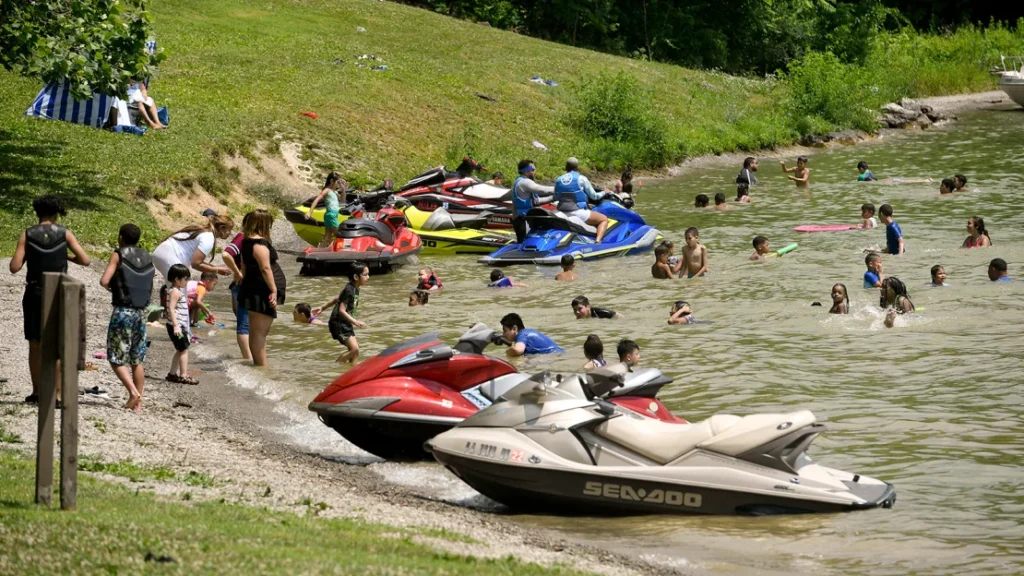
On Great Friday 2017, Wyatt Werneth got a call from his spouse, who had gone basic need shopping with their girl: The car’s broken down. If you don’t mind protect us.
Werneth jumped in his vehicle to help, driving by Patrick Space Drive Base close Cape Canaveral, Florida. From the A1A interstate, Werneth said you can see the ocean.
What he saw following was a bend of destiny that driven to a much more critical kind of rescue.
“I may see somebody waving in activity as I was going by. … I pulled in to see what was going on; I had the prompt intuitive that something was happening in the water,” Werneth reviewed to CNN Travel.
“When I came over the berm, I did not realize what I was getting into. There were numerous individuals in the water.”
And they were in inconvenience. Exceptionally genuine inconvenience. Tear current kind of trouble.
The scene would send chills of fear down anyone’s spine — but at slightest Werneth was arranged. He is an experienced lifeguard educators and had water protect gear with him.
But with at slightest five individuals battling in a horrendous Atlantic tear current, how would he conceivably spare them all?
The insights are grim
Whether it’s from these possibly unsafe tear streams or apparently peaceful lakes and swimming pools, the suffocating insights from the US Centers for Malady Control and Anticipation are shocking.
In the CDC’s most as of late upgraded numbers, more than 4,000 deadly inadvertent drownings happen each year in the Joined together States (counting sculling episodes). That is an normal of 11 suffocating passings per day. July tends to be the crest month for deaths.
From 2018 to 2021, the states with the most suffocating passings per 100,000 individuals were the following:
- Alaska
- Hawaii
- Montana
- Louisiana
- Florida
Your chances of suffocating are much, much higher than being assaulted by a shark or an alligator.
World suffocating measurements are indeed more stunning. There are an evaluated 236,000 yearly suffocating passings around the world, agreeing to the UN’s World Wellbeing Organization. That comes out to an normal of 647 individuals per day.
And at that point there are the indeed more various nonfatal drownings. The CDC says individuals who survive a suffocating occurrence have a extend of results: “From no wounds to exceptionally genuine wounds or lasting disability.”
The catastrophe is numerous of these passings and wounds are preventable, specialists say. What can you do to appreciate the water — be it sea, stream, lake or swimming pool — securely and not connect the positions of suffocating passings? Turns out, a lot.
Who is most at risk?
Knowing who is likely to suffocate is basic. At-risk bunches require the most consideration. In the Joined together States, those incorporate the following:
- The most youthful individuals: Children 1 to 4 have the most elevated suffocating rates, the CDC says, generally in swimming pools.
- Guys: They account for about 80% of deadly drownings in the Joined together States. More risk-taking behaviors and liquor utilize are cited as reasons. Over the world, WHO reports guys have twice the deadly suffocating rate of females.
- Individuals with seizure disarranges: Individuals with conditions such as epilepsy are at a higher hazard for suffocating, and that can happen in a bathtub.
Drowning anticipation tips
The CDC emphasizes the significance of learning essential water security abilities, saying formal lessons can diminish the hazard of drowning.
However, “children who have had swimming lessons still require near and steady supervision when in or around water,” the organization notes. Don’t get occupied by TV, books or the phone when observing children in the water.
If you’re drinking alcoholic refreshments, remain out of the water and don’t go sculling. Disabled judgment and moderate responses can lead to tragedy.
People in water crafts and weaker swimmers ought to wear life coats, particularly in open water.
And keep an eye on the climate. Exit if there’s a rainstorm or overwhelming rains.
Know the water environments
Understand the waters you’re approximately to enter. Distinctive bodies of water carry distinctive sorts of dangers:
OCEAN Tear CURRENTS
Rip streams stream absent from shore. They regularly frame at breaks in sandbars and near to wharfs and shake groins.
Look for signs of a tear current some time recently entering, says the Joined together States Lifesaving Affiliation. That can be “a limit crevice of darker, apparently calmer water between regions of breaking waves and whitewater,” a contrast in water color or “a line of froth, ocean growth or flotsam and jetsam moving seaward.”
American Gator in Everglades National Stop, Florida.
RELATED ARTICLE
How to survive an croc assault — or way better however, dodge one entirely
Here’s what to do you’re caught in one:
- Remain calm. Tear streams don’t drag you submerged but do clear you more distant from shore.
- Don’t swim against the current. Attempt to elude by “swimming out of the current in a heading taking after the shoreline,” the USLA says. You may be able to elude by drifting or treading water and ride the current out.
- If you’re in inconvenience, shout and wave for help.
If you’re not prepared, don’t attempt to protect individuals yourself. Look for a lifeguard, call 911 or toss a buoyancy gadget their way. Coordinate the individual to swim parallel to the shoreline to escape.
OTHER Sea TIPS
The National Climate Benefit cautions swimmers to observe out for “shorebreak” waves. They crash specifically onto the sand and can hitter and confuse swimmers. “When in question, don’t go out,” said Wyatt Werneth, who is moreover the open benefit representative for the American Lifeguard Association.
Swim Direct prompts individuals to swim in the hour some time recently or the hour after moo tide or tall tide when waters are by and large calmer. (But conditions can change shoreline to beach).
RIVERS
Tubing and other exercises are prevalent in streams. But quick streams and impediments underneath the surface or flotsam and jetsam can be hazardous.
Werneth said to inquire about the waterway some time recently you enter.
Related







